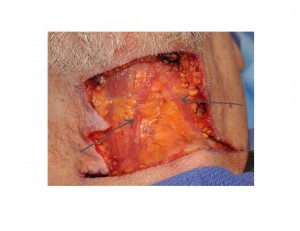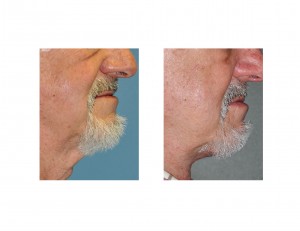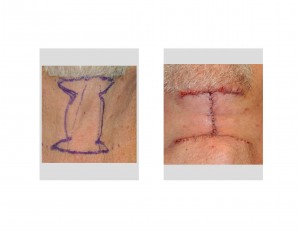Background: The neck sags with age due to the development of sagging skin and fat and the separation of the neck muscles which exposes the subplatysmal fat. These neck changes can become really pronounced as one reaches the sixth and seventh decades of life. This is the time that many men take notice of their growing neck wattles and may finally want to have it removed.
The standard method of neck rejuvenation in older patients, male or female, is the facelift. It is a procedure that is better described as a neck-jowl lift for it only affects the lower third of the face. It does so by using incisions around the ears and into the hairline for redistributing the loose neck skin up towards the ear where it could be removed. Good scar placement around the ears depends on careful placement, adequate hair density and the willingness to accept a certain period of recovery due to the extent of the skin undermining.
Many older men, however, do not want an extensive procedure with a prolonged visible recovery. They may also not have the hairline to support the extent of incisions needed around the ears to get the neck adequately lifted and tightened. An alternative necklifting technique is the direct necklift. As the name implies, it is the direct excision of the neck wattle.
Case Study: This 76 year-old male wanted to get rid of his neck wattle but didn’t want to have an ‘extensive’ facelift to do it. His turkeyneck had been growing and he didn’t like the flap of skin that he was seeing when he tilted his chin down. Even with his goatee, the neck skin could not be hidden.


The direct necklift is a very effective alternative to a facelift for the turkeyneck in older men. It is a short cut to a rejuvenated neck angle that does so at the price of neck scars. But these scars heal exceptionally well in the beard skin of the older male neck.
Case Highlights:
1) Neck sagging, often called a turkeyneck, is common in older men (> 65 years old) as they age.
2) Many older men want to have their neck wattle removed but don’t want to do a facelift to do it.
3) A direct necklift provides a fairly simple technique to remove the turkeyneck that has neck scars that are very acceptable in the beard skin of older men.
Dr. Barry Eppley
Indianapolis, Indiana



